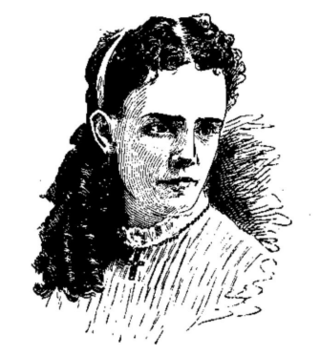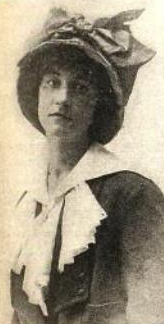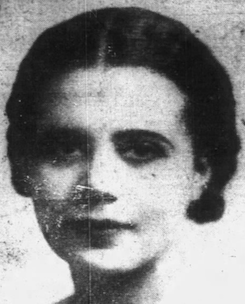
The Old Maid is a 1934 play by American playwright Zoë Akins, adapted from Edith Wharton's 1924 novella of the same name. The play as published has six "episodes", covering twenty-one years of time. It has a large cast, and three settings; one is used for the last four episodes (scenes). The story concerns two women, cousins, who allow rancor over a lost love to become a struggle for the illegitimate daughter of one.

Blanche L. Friderici was an American film and stage actress, sometimes credited as Blanche Frederici.

Mary Hanford Ford was an American lecturer, author, art and literature critic and a leader in the women's suffrage movement. She reached early notoriety in Kansas at the age of 28 and soon left for the Chicago World's Fair. She was taken up by the society ladies of the Chicago area who, impressed with her talks on art and literature at the Fair, helped launch her on a new career, initially in Chicago and then across some States. Along the way she was already published in articles and noticed in suffrage meetings.

Marion Benedict Cothren (1880–1949) was an American suffrage and peace activist, lawyer, and children's author.

Rosalie Slaughter Morton was an American physician, surgeon, and author. In addition to running her own medical practices, she became the first woman appointed as Attending Surgeon at the College of Physicians and Surgeons at Columbia University in 1916, and became the first chairperson of the American Women's Hospitals Service the following year. Morton served as a medic during the First World War, and was the first chair of the Public Health Education Committee. She was also one of the first women to join the faculty, and to later become a professor, at the Polyclinic Hospital of New York.

Florence Spencer Duryea was an American philanthropist and clubwoman, national secretary of Women's Organizations for Near East Relief, based in New York City.

Augusta "Gussie" Lewis Troup was a women's rights activist and journalist who advocated for equal pay, better working conditions for women, and women's right to vote. She was inducted into the Connecticut Women's Hall of Fame in 2013.

Ami Mali Hicks (1867–1954) was an American feminist, writer, and organizer. She wrote books on art instruction and criticism. Hicks was a longtime administrator for Free Acres, an independent, collectivized community in New Jersey. She worked with the Women’s Political Union and was a member of Heterodoxy, two radical organizations that challenged some of the more placid activism of women’s movements and suffragists.

Rose Rosenberg, CBE was a Jewish English woman who served as the private secretary for statesman Ramsay MacDonald from 1923 to 1935. Prior to her employment with MacDonald, she worked in the National Council for Civil Liberties with those opposed to conscription and was the personal assistant of suffragette, Margaret Mackworth, 2nd Viscountess Rhondda. She was known for her ability to keep secrets, monitoring those who wished to engage with MacDonald, and earned the nickname "Miss Rose of No. 10" from the international press. She was honored as a Commander of the Order of the British Empire in 1930. In later life, she worked for the British publicity office of Metro-Goldwyn-Mayer and in various positions during World War II providing assistance.
Alice W. Wiley Seay was an American social worker and founder of the Empire State Federation of Women's Clubs. She was also involved in charity work through the Dorcas Society and women's clubs. She held leadership roles in many of these organizations.

Irene Moorman Blackstone was an African-American businesswoman and club member who became active in the fight for women's suffrage. Along with Alva Belmont, she initiated the interracial cooperation of women in the drive for enfranchisement. When the 19th Amendment passed, she turned her activism toward the Universal Negro Improvement Association (UNIA) and other programs which worked to uplift the black community and prevent the exclusion of and discrimination against blacks in attaining socio-economic and political equality.

Emma S. Connor Ransom was an American educator and clubwoman, active in the African Methodist Episcopal Church (AME) and the YWCA.

Marie Frugone, later Marie Frugone Scileppi, was an American journalist and community leader, who wrote for the Brooklyn Daily Eagle and the Brooklyn Times-Union in the 1930s. She worked with the Red Cross in France and Italy during World War I.
Harriet T. Righter was an American businesswoman, the president of Selchow and Righter, a game company, which was co-founded by her father. Her best-known addition to the company's properties was Scrabble, which she thought was "a nice little game".

Rosalie Loew Whitney was an American lawyer and suffragist.

Elisabeth Worth Muller was an American suffragist.

Evelyn Straus was an American photojournalist and the first woman employed as a photographer at the Daily News in New York City. She was one of the first women admitted to the National Press Photographers Association in 1945 and joined the Press Photographers Association of New York City in 1952 as soon as they allowed women as members. During her career, she was a finalist for the Pulitzer Prize for Photography and had work featured at the Museum of Modern Art.

Sara Pelham Speaks was an American lawyer and activist. She was the first Black woman to be a major party's nominee for a Congressional seat, when she was the Republican candidate who opposed Adam Clayton Powell Jr. in 1944.

Eugénie M. Rayé-Smith was an American lawyer, educator and suffragist.
Jeanette Brill née Goodman was a Jewish-American lawyer and magistrate from Brooklyn. She was the first woman to serve as Deputy Attorney General of New York and the first woman magistrate in Brooklyn.

















